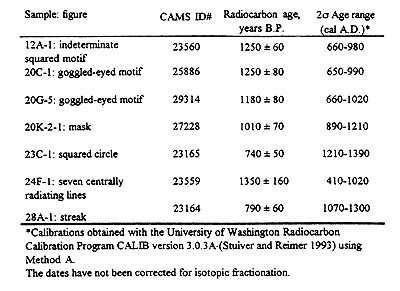Dating Rock Art
|
Determining age and cultural affiliation of rock art at Hueco Tanks is not an exact science. Direct dating of pictographs utilizes samples of organic materials present in the pigments, chiefly charcoal. Archeologists can determine the age of a charcoal sample by measuring its carbon content. Though the science of radiocarbon dating was greatly advanced by the advent of accelerator mass spectrometry, which can evaluate the age of even minute samples of charcoal, dating rock art is still problematic. Accelerator mass spectrometry (AMS) allows archeologists to avoid doing much damage to the rock art they wish to date, since it is able to determine the age of very small amounts of charcoal. However, in an effort to keep damage to rock art to a minimum, archeologists sometimes take samples of pigment that are so small they do not contain enough charcoal to date. Archeologists are also often reluctant to take samples from intact paintings, and take them instead from nearby damaged paintings or paint streaks. There is no guarantee, however, that these other paintings are contemporaneous with the intact ones. |
 |
Samples were taken of 15 rock art paintings at Hueco Tanks, chiefly from areas that were damaged or not integral parts of design elements. The images sampled include “goggled-eyed masks, masks, and a sheep-like animal. Low-pressure oxygen and argon plasmas coupled with radiocarbon AMS were used to date charcoal pigments from these paintings. Texas A&M chemist Marvin Rowe found that seven of the samples had sufficient carbon to provide data for analyses; these returned dates ranging from 1350 ± 160 years ago to 740 ± 50 years ago. Several problems, such as the unknown species of wood used for the charcoal, require us to be cautious: the dates should be considered provisional rather than conclusive. The range is somewhat earlier than anticipated ages of 950 to 500 years ago. Most fall within the earliest phase of the Formative period, the Mesilla phase, and others fall within the transitional, or Dona Ana phase, the time of the Hueco Tanks villagers. Another difficulty with radiocarbon dating rock art is the possibility of carbon contamination of the pigment samples submitted for testing. Rock art pigments can be contaminated by carbon from plant and animal (particularly human) interference, as well as from the very rocks that they were applied to. Though carbon contamination can be obvious, such as when rock art is vandalized (and subsequently cleaned) by modern people, it can also be very difficult to recognize. Contamination by microscopic plants and animals or airborne particles is often impossible for archeologists to detect until they are in the laboratory. Until a larger and more reliable suite of dates can be obtained, most of our age determinations of the site’s rock art will continue to be derived from cross-cultural comparisons with other sites and through recognition of specific cultural motifs. |